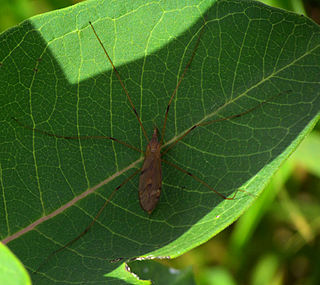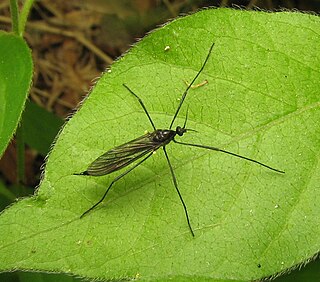
Limonia is a genus of crane flies in the family Limoniidae. There are at least 430 described species in Limonia. It is somewhat of a 'catch-all' genus, where some members should rightly be placed elsewhere.

The Ropalomeridae are a family of acalyptrate flies.
Gymnocarena is a genus of fruit flies in the family Tephritidae and tribe Xyphosiini, characterized by pale yellow bodies and dappled wings as opposed to the other genus in Xyphosiini, Icterica. There are about 14 described species in Gymnocarena.

Eriopterini is a tribe of limoniid crane flies in the family Limoniidae. There are more than 20 genera and 3,800 described species in Eriopterini.

Cladura flavoferruginea is a species of limoniid crane fly in the family Limoniidae.
Pseudolimnophila luteipennis is a species of limoniid crane fly in the family Limoniidae.
Limnophila marchandi is a species of limoniid crane fly in the family Limoniidae.
Limonia domestica is a species of limoniid crane fly in the family Limoniidae.
Limonia duplicata is a species of limoniid crane fly in the family Limoniidae.

Limoniini is a tribe of limoniid crane flies in the family Limoniidae. There are about 7 genera and more than 1,400 described species in Limoniini.
Chionea scita is a species of crane fly in the family Limoniidae. C. scita is known as a type of snow crane fly because it is commonly seen walking on piles of snow during the winter months. These flies are also often observed in caves and heavily wooded areas. C. scita flies are small, hairy, wingless, and somewhat spider-like in appearance, unlike other flies.
Erioptera caliptera is a species of limoniid crane fly in the family Limoniidae.
Dicranoptycha elsa is a species of limoniid crane fly in the family Limoniidae.

Limonia triocellata is a species of limoniid crane fly in the family Limoniidae. Three eye-like spots can be found on each of its wings, from which it derives its scientific name. It can be found primarily in the eastern United States and Canada especially during either of its two flight periods from May-June and September-October.
Helius flavipes is a species of limoniid crane flies in the family Limoniidae.

Gnophomyia tristissima is a species of limoniid crane flies in the family Limoniidae. It is all black with yellow halteres.
Hexatoma brachycera is a species of limoniid crane flies in the family Limoniidae.
Toxorhina muliebris is a species of limoniid crane fly in the family Limoniidae. The adult of the species can be found flying in mid-June to August on the East Coast of North America from Quebec to Virginia and as far west as Wisconsin. Its grayish color is the most obvious difference from the yellowish brown Toxorhina magna which is found in the southern parts of the range of T. muliebris.
Toxorhina alexanderi is a species of limoniid crane fly in the family Limoniidae. This tropical African species is known from a specimen taken in The Gambia, stored at the Lund Museum of Zoology Insect Collection at Lund University in Lund, Sweden.
Paradelphomyia americana is a crane fly in the family Limoniidae found in Central and South America. It was previously included in the genus Toxorhina but has been reclassified.





